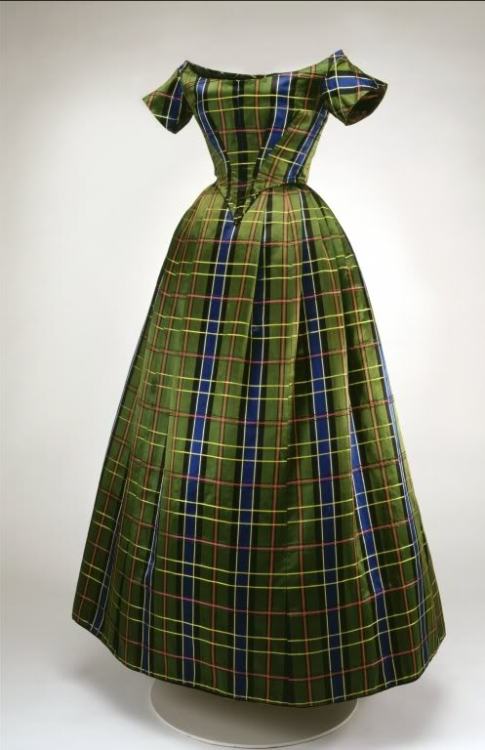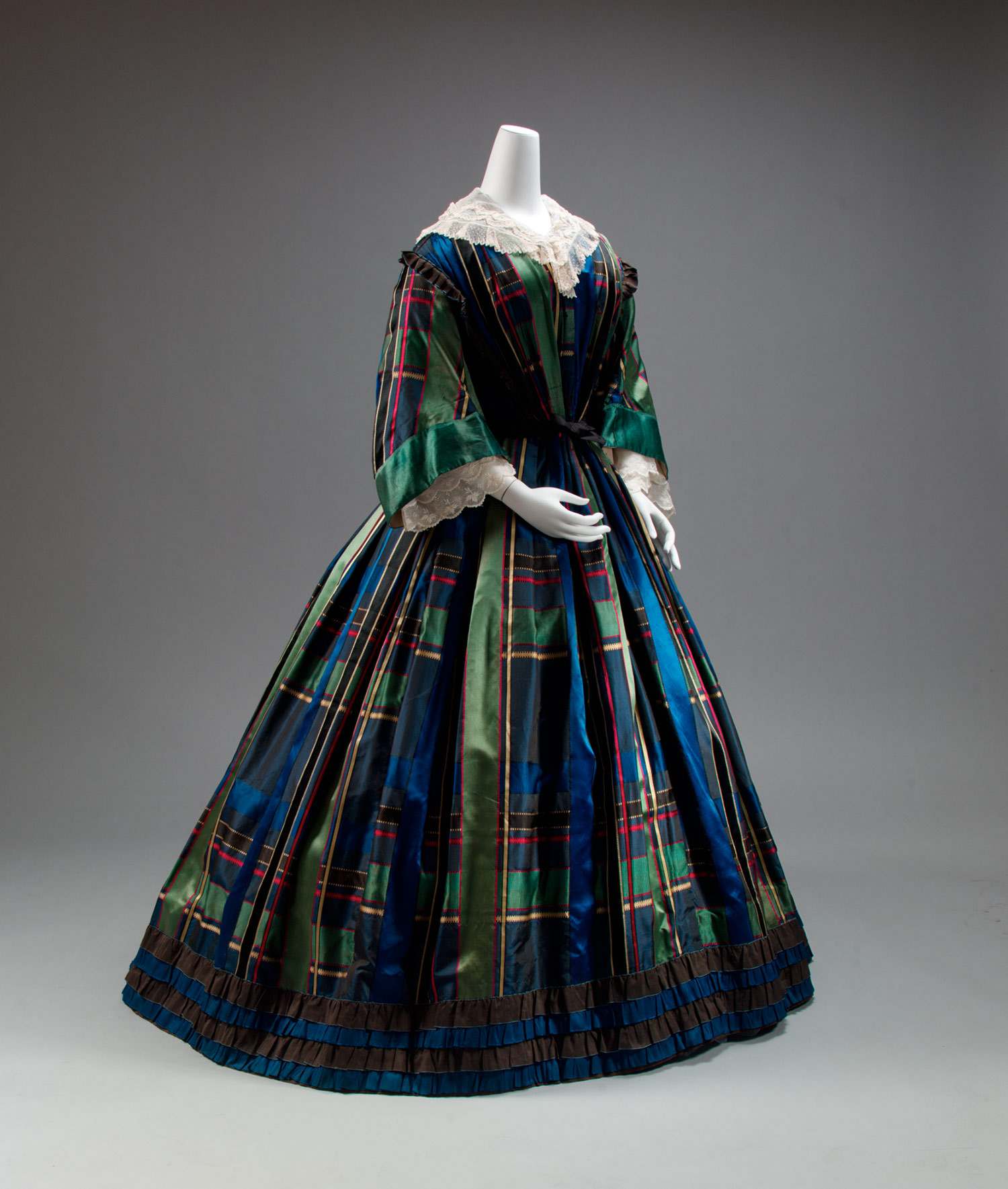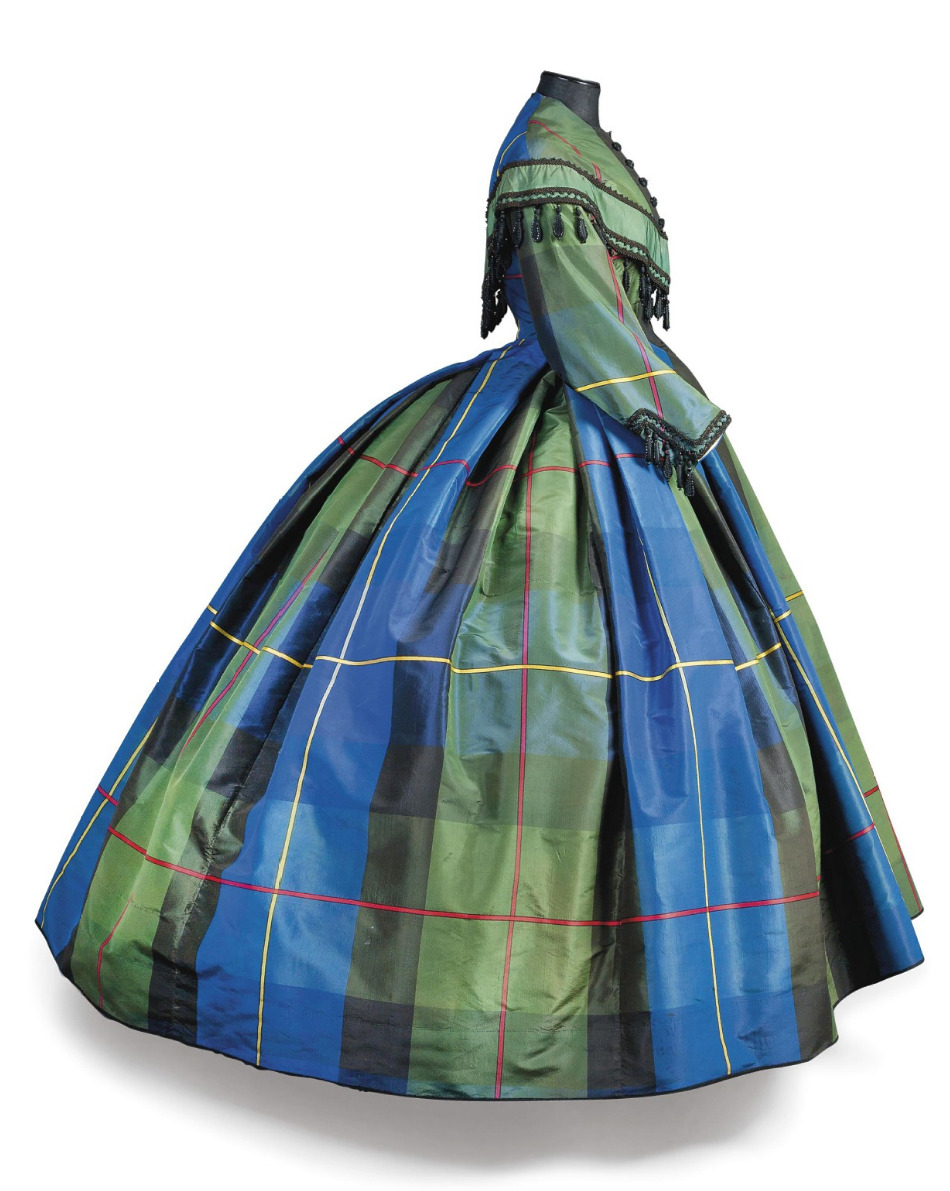Where we left off, Queen Victoria had fallen in love with the Scottish Highlands and created a fad for "clan tartans," trips to the Highlands, and tartan gowns...but there was another actor at play in the mid-nineteenth century that contributed to some of the more wild and crazy and fabulous patterns of the period: the rise of chemical dyes in fashion.
 |
| plaid gown (with evening bodice), Musee McCord, Montreal |
| Buchanan Clan tartan, registered 1850 |
| Akins Clan tartan, registration thread count from a pair of trews c. 1820 |
| Dunbar tartan, 1842 (there's an alternate sample dating 1850 for the same sett) |
Talk about loud! They almost make dresses made entirely of Victoria's Royal Stuart (a quite popular choice at the time) seem downright subtle.
 |
| day dress, 1860s, in Roysl Stuart with green trim |
In 1856, William Perkin (a student in the laboratories at the Royal College of Chemistry), began a project to investigate synthesizing quinine (used to treat malaria and a fairly new discovery). While his experiments failed, Perkin discovered that his not-quinine synthesized chemical turned fabric purple, and did not appear to wash out or fade in the sun. He sent the dye to well-respected colorists in Perth, Scotland, for evaluation.
Patented in 1857, Perkin's dye of aniline sulphate and potassium bichromate became one of the first popular chemical dyes, "for dyeing with a lilac or purple color stuffs of silk, cotton, wool, or other materials" (from the patent). The color became known as mauveine, or "Perkin's Mauve."
 |
| letter from Perkin's son with a sample of dyed silk |
 |
| a stunning late dress, c.1870, dyed with mauveine |
Perkin's Mauve was all the rage. Charles Dickens wrote in 1859, “As I look out of my window, the apotheosis of Perkin’s purple seems at hand – purple hands wave from open carriages – purple hands shake each other at street doors – purple hands threaten each other from opposite sides of the street; purple – striped gowns cram barouches, jam up cabs, throng steamers, fill railway stations : all flying countryward, like so many birds of purple paradise” (from All Year Round).
Around the same time, aniline was also used as a base for a new red dye, called fuchsine (1859). A blue dye from aniline was next in 1863, and with it came a major breakthrough. Made by heating chemicals and mixing them with the red aniline dye, chemical analysis of the aniline blue determined that a similar process (called "alkylation") could be used to create many other colors as well.
 |
| a lovely aniline blue dress |
 |
| red silk boots, c.1865-75 made with red aniline dye |
And with that, brighter, wilder colors were all the rage. Written in 1869, this description of England is perhaps my favorite. English fashion included ‘violet dresses of a really ferocious violet, purple or poppy red silks, grass-green dresses decorated with flowers, azure blue scarves and dresses of purple silk, very shiny so that they reflect the light dazzlingly...The glare and glitter is brutal.’ I want to be brutally glittery. New life goal.
The bright colors afforded by aniline dyes (as well as other chemical variations) opened up a world of fashionable possibilities.Perhaps most importantly, this type of chemical dyes was more colorfast than older methods, meaning it was much less likely to run or bleed--and could therefore be used in patterns.
 |
| plaid day dress, 1857, made with chemical dyes (Met Museum) |
 |
| late 1860s plaid silk dress, auctioned at Christies |
 |
| satin plaid, 1860s, via Museum of Fashion, Bath |
 |
| plaid wrapper, 1860s |
The rise of chemical dyes made bright colors accessible to a large audience, and combined with the popularity of tartans to create a whole new breed of plaid. While tartans had been bright and colorful before aniline, now it was possible for the combinations to become trends. While muted colors did come back into fashion relatively soon, the penchant for bright plaids stuck around. Why wouldn't they? Those are some truly fabulous dresses.
For more about chemical dyes, check these out:
Morris, P., & Travis, A. "A History of the International Dyestuff Industry." American Dyestuff Reporter, 81(11), 1992.
Fukai, A. "The Colors of a Period as the Embodiment of Dreams." Fashion in Colors, Kyoto Costume Institute.
Forster, S. & Christie, R. "The significance of the introduction of synthetic dyes in the mid 19th century on the democratisation of western fashion." Journal of the International Colour Association, 11, 2013. pp.1-17.
Greenfield, A. A Perfect Red. New York: Harper Perennial, 2005.


Nicely summarized and very informative! I love your wealth of examples from a variety of museums as well. I'm contemplating a brightly colored dress for Mechanics Hall next year... want to coordinate in brights? ;)
ReplyDeleteQuinn
I'm glad you liked the post! It's been sitting in my drafts box waiting for attention since Returning Heroes...and yes! I would love to coordinate in brights for Mechanics Hall :)
DeleteYay Buchanan Tartan! I'll have to figure out a way to wear my kilt to a ball soon...
ReplyDeleteThe Buchan tartan has been around since c1800 so the 1850 date is misleading - http://www.scottishtartans.co.uk/Buchanan.pdf
ReplyDeleteWould love to know where the alleged c1820 Akins trews are. It's a very dubious claim.
I'm not sure where the 19th century date for the Wren tartan comes from. It was first recorded in the late 1990s.
Hi Peter,
DeleteThanks for your feedback. All of the images and dates on the tartans in this post come from the Scottish Register of Tartans, which I use as my "official" source for all tartan registration info.
The SRT lists the date for this Buchanan tartan as 01/01/1850, and includes this information: "In their 1850 book 'The Clan and Family Tartans of Scotland' W and A Smith of Mauchline wrote: The pattern here given seems to be universally considered the genuine Buchanan Tartan and we know that it is worn by Archibald Buchanan Esq, of Catrinebank, Ayrshire, whose father's name is identified with one of the first cotton manufactories established in Scotland with Arkwright's improvements.' The woven sample in the 1880 Clans Originaux agrees with this sett."
For the Akins trews, unfortunately I don't have much more information! The SRT lists the date for this tartan (Akins Clan (Personal)) as 01/01/1820, and my caption is a quote from the SRT's registration note.
The Wren tartan doesn't have a date in the SRT, so it's possible I misinterpreted the notes there. Thanks for your feedback--I've updated this accordingly with a tartan I can more firmly date :)